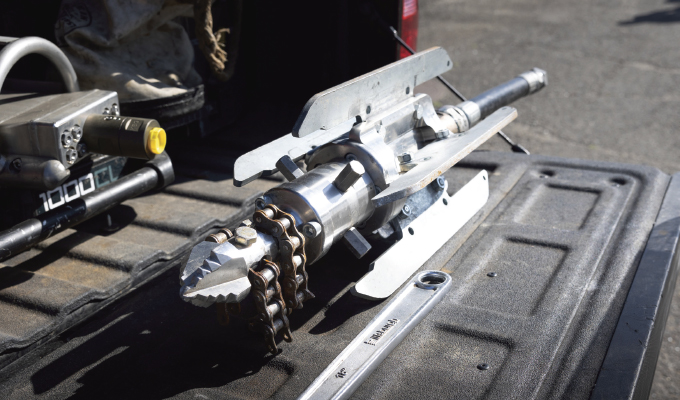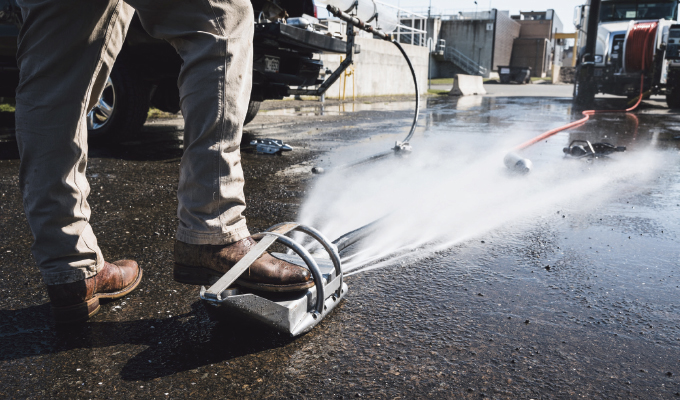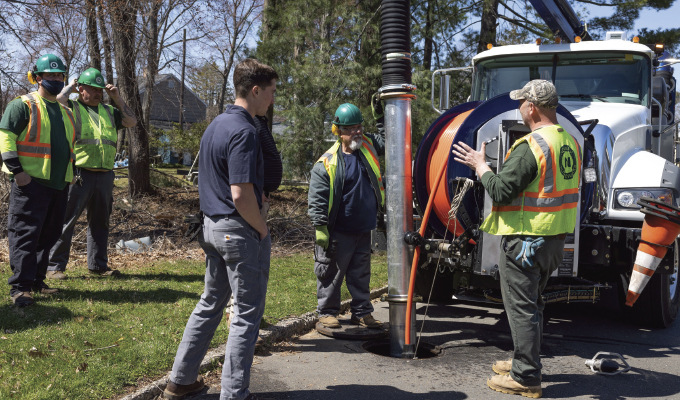Most municipalities are fully aware that preventing sewer overflows is a national enforcement priority for EPA, yet many struggle to stay compliant. Too often, when municipalities are short-staffed and must maintain miles of sewer line, they end up simply responding to emergencies. Instead, a growing number of proactive municipalities are choosing to utilize the most effective tools and techniques, which is helping them to properly maintain the line and stay EPA compliant.
“EPA’s compliance goal is to eliminate sanitary sewer overflows (SSOs) from municipal collection systems and to ensure that wastewater is being conveyed to treatment plants in accordance with the requirements of the Clean Water Act. To eliminate SSOs, EPA uses a mix of compliance and enforcement tools,” according to the agency’s website.
SSOs are overflows or releases from sanitary sewer systems and are illegal under the Clean Water Act. SSOs have a variety of causes, including but not limited to severe weather, improper system operation and maintenance, as well as vandalism. EPA estimates that there are at least 40,000 SSOs each year. The untreated sewage from these overflows can contaminate the nation’s waters, causing serious water quality problems. It can also back up into basements, causing property damage and threatening public health.
“Today, one of the greatest underlying causes of SSOs is sewer pipe blockages due to growing tree roots that enter through line defects or openings, combined with inappropriate materials sent to sewers. This includes fats, oils, and grease along with products like baby or facial wipes, sanitary pads, and tampons. Non-degradable wipes are a particular problem when flushed because they get hung up in roots and start catching all the grease and debris. Everything builds until the line is stopped, which leads to an SSO,” says Dan Story, operations manager at KEG Technologies, a manufacturer of sewer and storm line products including nozzles, chain cutters, and camera nozzle systems. The Spartanburg, South Carolina-based company is a member of NASSCO, the National Association of Sewer Service Companies.
Proactively preventing blockages and removing those in progress is critical because failing to do so can lead to devastating consequences. “Sewer pipes fill up from any blockage and can back up into homes or run down the street, so the federal government mandates that a certain amount of sewer line must be properly maintained annually, or fines are levied,” says Story.
Fortunately for municipalities, using the industry’s most effective tools and techniques can virtually eliminate SSOs, and in some instances, have done so for decades. This is first achieved by preventing most sewer line blockages with powerful nozzles and efficient cleaning. Next, camera nozzles can quickly identify developing blockages during routine cleaning without deploying a separate camera crew. When the blockages must be removed, utilizing various cutters including robust chain cutters can do so quickly and efficiently. Finally, learning the most effective cleaning techniques from experts in the industry can further facilitate proper sewer line maintenance.

PREVENTING SSOs
Properly designed, operated, and maintained sanitary sewer systems are meant to collect and transport all the sewage that flows into them to a publicly owned treatment works (POTW). However, occasional unintentional discharges of raw sewage from municipal sanitary sewers occur in almost every system.
The first line of defense against such SSOs is to use effective tools, specifically powerful nozzles, to sufficiently clean sewer lines and remove any debris so it does not accumulate to become a blockage. In this effort, using high-performance Tier 3 nozzles instead of lower performing Tier 1 or 2 nozzles can be an important advantage.
Although rated for water efficiency (Tier 1: about 30 percent efficient; Tier 2: 50 to 60 percent efficient; and Tier 3: 75 to 98 percent efficient), top Tier 3 nozzles can also more reliably direct the most force with less water, at lower pressure, to remove debris. The most efficient Tier 3 nozzles, such as KEG’s Torpedo and OMG models, are designed with fluid mechanics engineering on a par with the aerodynamics of race cars. After exiting the jetter hose, water travels into the body of the nozzle before moving through smooth, curved channels. This design enables the water to maintain its power and speed before entering the nozzle’s replaceable titanium ceramic inserts, which help to straighten the water stream. The water is further funneled to enable an even tighter water pattern to emerge.
The power and reliability of a superior Tier 3 nozzle can help operators clean more line, more effectively, before the sewer truck crew needs to stop work and drive to a hydrant to refill the water tank before resuming work. According to Story, a Tier-1, 30-degree drilled nozzle running 72 gallons per minute at 2,200 psi will only exert 13 pounds of force to move debris nine feet away from the nozzle. In contrast, a high-efficiency Tier-3 nozzle running 60 gallons per minute at 2,000 psi will exert 98 pounds of force 9 feet away.
IDENTIFYING OBSTRUCTIONS
The EPA can hold municipalities accountable for preventing SSOs in hundreds or thousands of miles of sewer line annually. In addition, proper cleaning and maintenance must be accomplished. For these reasons, waiting for a separate crew with a CCTV truck to access pipe conditions can be insufficient. Out of sight, obstructions will develop into blockages that trigger SSOs when the camera crew cannot assess all line on a regular basis.
To enable timely sewer line inspection when a CCTV truck crew is unavailable, some manufacturers in the industry have developed camera nozzles that capture video while cleaning. As an example, KEG’s KleenSight camera-nozzle system provides operators with the ability to clean sewer and storm lines while recording upright high-definition video. The device has a self-leveling camera head and provides its own illumination. Only a jetter hose connection is required—no cables or wires. The camera captures the video in memory and the files are automatically date- and time-stamped for later downloading by wi-fi to mobile devices or PCs for viewing.
Using a nozzle-camera during routine cleaning can capture video that shows if there are roots in a pipe that should be removed before they become a problem.

REMOVING OBSTRUCTIONS
When a serious blockage occurs, it usually results in an SSO, and a chain cutter is used to resolve the situation. Most are hydraulically powered. Although this reduces the overall cost of the unit, many hydraulic cutters supply insufficient power or torque to cut through the heavy roots, hard mineral deposits, grease, or wipes that can be at the core of a blockage. In some cases, the chain cutter can stall or seize up.
“Chain cutter nozzles that utilize water pressure are more efficient and can deliver the required torque to cut through thick masses,” advises Story. “The high-pressure water enters the chain cutter nozzle chamber and is directed to spin the cutting chains at high velocity.”
As an example, he points to a powerful chain cutter that has a high-speed, high-torque, water-driven design. The chain cutter can eliminate heavy root blockages as well as scale, rust, mineral deposits, hardened grease, and accumulated debris.
“When you remove the roots and debris from the lines, it becomes easy for future debris to pass through on its own. This eliminates the problem of backing up and sanitary sewer overflow,” says Story.
PROACTIVE, NOT REACTIVE
When SSOs occur and municipalities are out of EPA compliance, it can be difficult to do more than react. However, proactively maintaining sewer line with the most effective tools and tactics is vital to prevent SSOs and quickly resolve them if they occur. For this reason, KEG offers customized training programs to municipalities that specifically target the challenge of SSOs.
With the goal of eliminating SSOs, the training program corrects common cleaning errors, such as excessive operator speed going up the sewer line, which ends up wasting water, labor, and time when multiple passes are required. Proper line assessment and cleaning speed are taught, which allow operators to adjust to circumstances as needed while minimizing water use.
When operators complete the training, most will understand how to “chop up the debris and let the flow of water work like a conveyor belt, carrying the debris out.” They will be trained to “go from manhole to manhole and clean in a single pass.” It takes a fraction of the time and resources to make one pass versus making several passes to remove the same material.
The results of being proactive with equipment and training to minimize SSOs have been more successful than might be expected.
“One city in Arizona that we have worked with has not had an SSO in thirty years. It’s all about staying on top of your game,” concludes Story.
FOR MORE INFORMATION
Del Williams is a technical writer based in Torrance, California. KEG Technologies Inc. is headquartered in Spartanburg, South Carolina. KEG`s patented fluid mechanics directs high pressure water from a truck or jetter hose in a manner so efficiently they were granted a United States patent, meaning operators can usually clean pipes using less pressure, less fuel consumption, and less time than other less efficient nozzles. For more information, call 866.595.0515 or visit www.kegtechnologies.net.
MODERN PUMPING TODAY, December 2022
Did you enjoy this article?
Subscribe to the FREE Digital Edition of Modern Pumping Today Magazine!


